ADCS Attack Paths in BloodHound — Part 1

ADCS Attack Paths in BloodHound — Part 1
Since Will Schroeder and Lee Christensen published the Certified Pre-Owned whitepaper, the BloodHound Enterprise team at SpecterOps has been eager to implement Active Directory Certificate Services (ADCS) attack paths in BloodHound. However, the complexity of ADCS presented challenges in creating simple-to-use BloodHound edges for covering ADCS domain escalations. That’s why we are thrilled to announce that BloodHound now supports ADCS attack paths as an early access feature.
This blog post details the ESC1 domain escalation requirements and explains how BloodHound incorporates the relevant components. We will demonstrate how to effectively use BloodHound to identify attack paths that involve ESC1 abuse.
If you are new to ADCS attacking techniques or need a recap of how ADCS works, we recommend reading through the Background section of the Certified Pre-Owned whitepaper. For those who prefer watching over reading, check out the recording of our webinar: AD CS Attack Paths in BloodHound.
Acknowledgments
The community has played a crucial role in our work by sharing research and tooling on ADCS. A big thank you to everyone contributing knowledge!

Special thanks to Oliver Lyak for publishing insightful writeups on escalations, providing a useful tool for ADCS abuse with Certipy, and creating a forked version of BloodHound with ADCS support. Your work has been extremely valuable for us and a great source of inspiration.
ADCS in BloodHound
With the implementation of ADCS attack paths in BloodHound, we introduce a multitude of non-traversable edges. Let’s first understand the concept behind traversable and non-traversable edges before delving into the new features.
Traversable Edges
Most edges in BloodHound are traversable, representing a relationship between two nodes where the starting node can take control of the ending node to a degree that allows an attacker to abuse outgoing edges.
For example, consider the ForceChangePassword edge:

The Service Desk group has permission to force change the password of Bob without knowing Bob’s current password. An attacker can abuse this to change the password, log in as Bob, and exploit Bob’s privileges. Traversable edges like ForceChangePassword facilitate graph traversal and enable the pathfinding logic in BloodHound.
Non-Traversable Edges
If you cannot abuse a given relationship between two nodes to take control of the end node, then the relationship is non-traversable. However, some relationships are non-traversable but can form a traversable relationship when combined. An example is the DCSync attack narrative, discovered and implemented into mimikatz by Vincent Le Toux. GetChanges and GetChangesAll permissions on the domain object combined enable you to perform the DCSync attack. GetChanges and GetChangesAll are non-traversable edges, and BloodHound uses them to produce the traversable DCSync edge in what we call the post-processing logic.
Pathfinding includes only traversable edges. As a result, you might get a DCSync edge in a path like this:

But you will not see any GetChanges or GetChangesAll edge. However, you can use Cypher to reveal the GetChanges and GetChangeAll edges that the DCSync edge relies on:
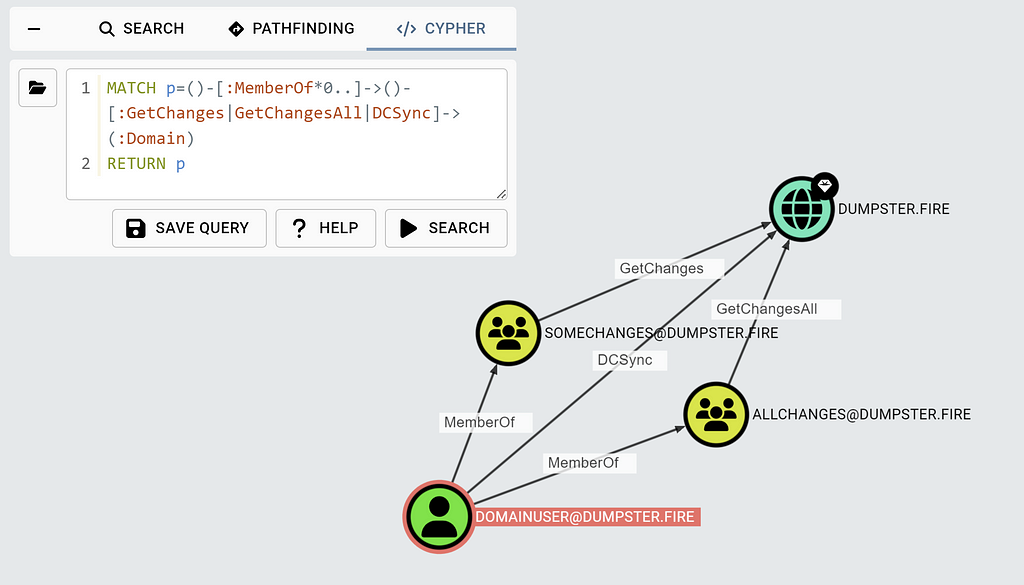
ESC1 in BloodHound
The Certified Pre-Owned whitepaper outlines the ESC1 requirements:
- 1) An overly permissive certificate template security descriptor grants certificate enrollment rights to low-privileged users.
- 2) The certificate template allows requesters to specify a subjectAltName in the CSR.
- 3) The certificate template defines EKUs that enable client authentication.
- 4) Manager approval is disabled.
- 5) No authorized signatures are required.
- 6) The Enterprise CA grants low-privileged users enrollment rights.
Additionally, the Enterprise CA must meet the following requirements for a successful ESC1 attack:
- 7) The Enterprise CA is trusted for NT authentication.
- 8) The Enterprise CA’s certificate chain is trusted.
Last but not least, there is an implicit requirement:
- 9) The Enterprise CA has the certificate template published.
We will now go through the requirements one by one to explore how we have implemented them in BloodHound and how we can find the principals that can perform an ESC1 attack.
Certificate Template Requirements
We have introduced a new node type called CertTemplate to represent the AD objects of the pKICertificateTemplate LDAP class:
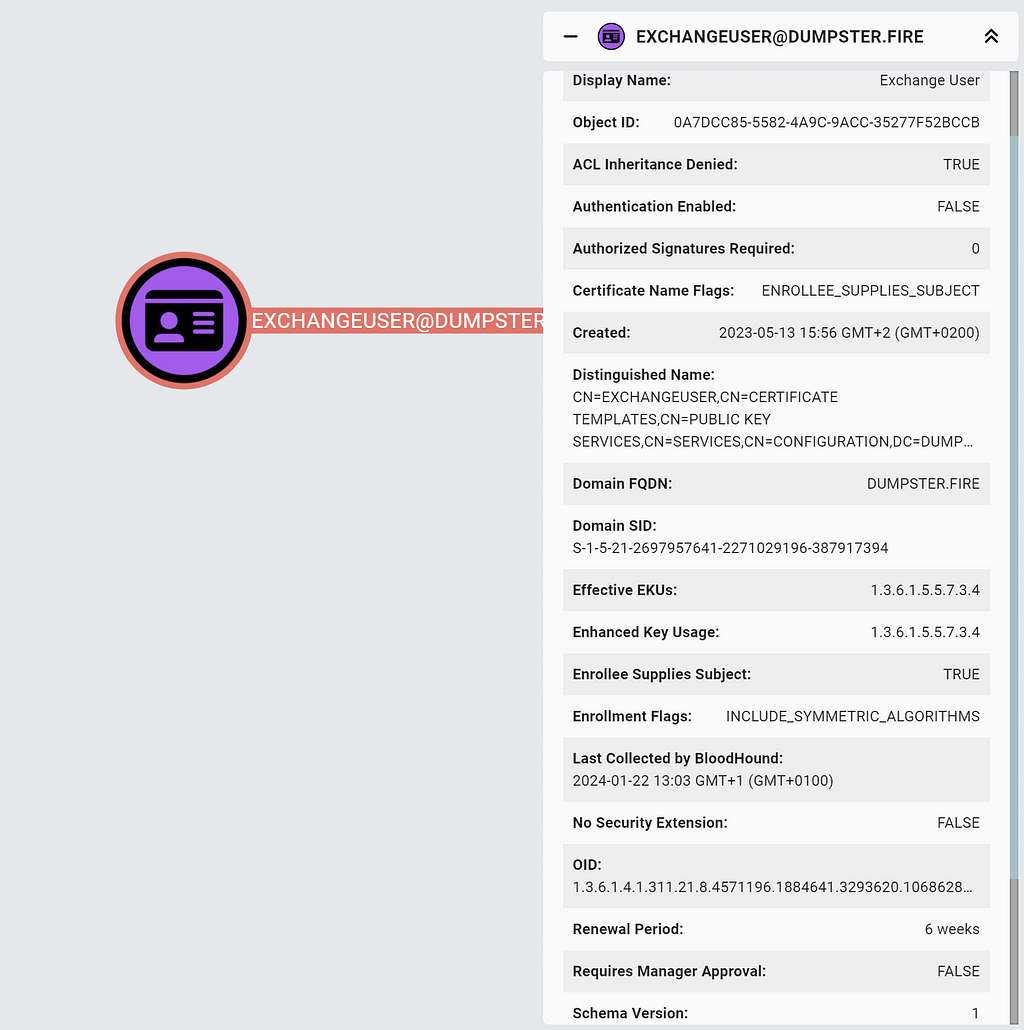
Let’s delve into the CertTemplate node properties and relevant edges through the ESC1 requirements.
ESC1 Requirement 1: An overly permissive certificate template security descriptor grants certificate enrollment rights to low-privileged users.
The enrollee principal must have at least one of the following permissions/edges on the certificate template to enroll a certificate:
- Certificate-Enrollment extended right: Enroll edge (new!)
- All extended rights: AllExtendedRights edge
- GenericAll (Full Control) access right: GenericAll edge
To find all principals with certificate enrollment rights, use this Cypher query:
MATCH p = ()-[:Enroll|AllExtendedRights|GenericAll]->(ct:CertTemplate)
RETURN p
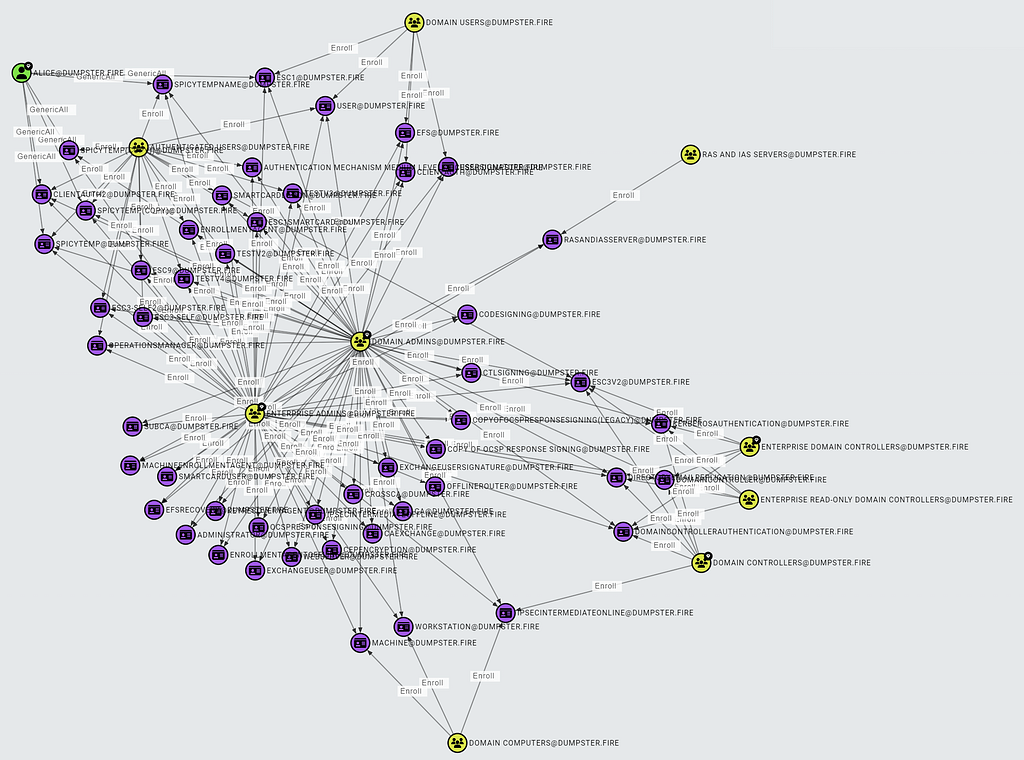
ESC1 Requirement 2: The certificate template allows requesters to specify a subjectAltName in the CSR.
The certificate template allows the enrollee to specify the subjectAltName (SAN) in the issued certificate if the template has the CT_FLAG_ENROLLEE_SUPPLIES_SUBJECT flag present in its msPKI-Certificate-Name-Flag attribute. You can check if the flag is present in BloodHound under “Enrollee Supplies Subject” in the CertTemplate entity panel or by checking the CertTemplate node’s enrolleesuppliessubject property.
We can use the enrolleesuppliessubject node property to extend our query to filter out certificate templates without the CT_FLAG_ENROLLEE_SUPPLIES_SUBJECT flag:
MATCH p = ()-[:Enroll|AllExtendedRights|GenericAll]->(ct:CertTemplate)
WHERE ct.enrolleesuppliessubject = True
RETURN p
ESC1 Requirement 3: The certificate template defines EKUs that enable client authentication.
The Certified Pre-Owned whitepaper explained how the certificate template must have one of the following EKUs (Extended Key Usages) in its pKIExtendedKeyUsage attribute:
- Client Authentication (1.3.6.1.5.5.7.3.2)
- PKINIT Client Authentication (1.3.6.1.5.2.3.4)
- Smart Card Logon (1.3.6.1.4.1.311.20.2.2)
- Any Purpose (2.5.29.37.0)
- SubCA (no EKUs)
However, the pKIExtendedKeyUsage attribute is not the only attribute made for EKUs. There is another attribute named msPKI-Certificate-Application-Policy. So does that attribute enable authentication as well?

It is the EKUs that end up in the Enhanced Key Usage (2.5.29.37) property of the issued certificate that are the effective EKUs. Our testing showed that the schema version of the certificate template and whether the certificate has attributes pKIExtendedKeyUsage and msPKI-Certificate-Application-Policy configured with EKUs or not set (Null) affect the content of the Enhanced Key Usage (2.5.29.37) property:

msPKI-Certificate-Application-Policy takes precedence over pKIExtendedKeyUsage unless the certificate template is of schema version 1 and pKIExtendedKeyUsage contains EKUs.
We do not expect anyone to remember this rule. To make life easier, we added a couple of extra properties to the CertTemplate node:
- Effective EKUs (effectiveekus): The effective EKUs based on the logic above.
- Authentication Enabled (authenticationenabled): Whether the effective EKUs enable authentication.
We have the LDAP attributes represented with properties as well:
- Schema Version (schemaversion): Reflects msPKI-Template-Schema-Version attribute.
- Enhanced Key Usage (ekus): Reflects pKIExtendedKeyUsage attribute.
- Certificate Application Polices (certificateapplicationpolicy): Reflects msPKI-Certificate-Application-Policy attribute.
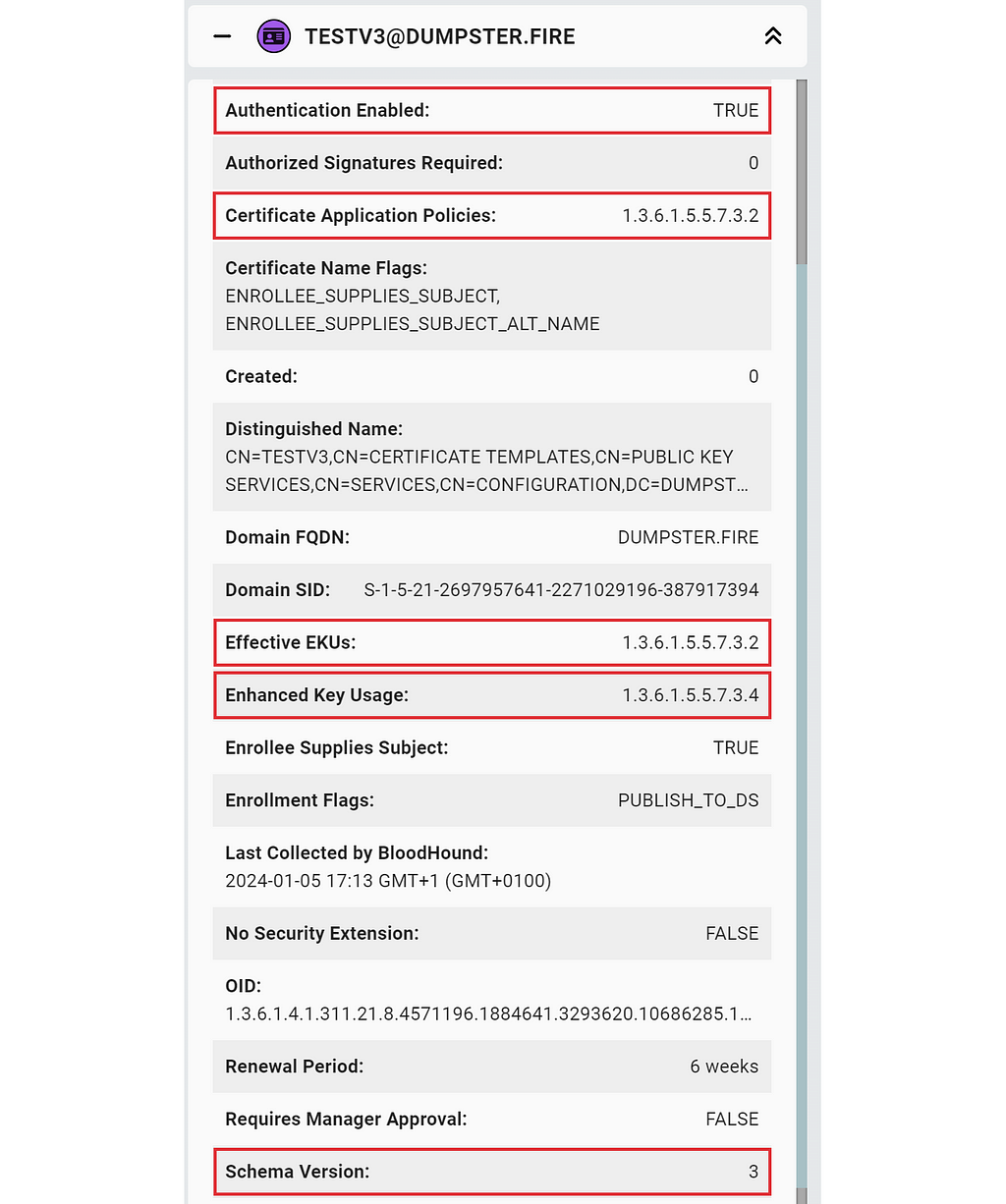
If you assessed certificate templates for ESCx opportunities based on pKIExtendedKeyUsage EKUs only, you may have encountered false positives or false negatives, but likely not. The msPKI-Certificate-Application-Policy attribute is Null by default for schema version 1 templates, and in version 2 and above, the msPKI-Certificate-Application-Policy and pKIExtendedKeyUsage attributes are identical by default. If you edit the EKUs through the Windows built-in Certificate Template Manager GUI, it will set both msPKI-Certificate-Application-Policy and pKIExtendedKeyUsage to the chosen set of EKUs. That means pKIExtendedKeyUsage does hold the effective set of EKUs unless you tamper with the attributes in some other way.
To conclude the requirement, we add authenticationenabled = True to our Cypher query:
MATCH p = ()-[:Enroll|AllExtendedRights|GenericAll]->(ct:CertTemplate)
WHERE ct.enrolleesuppliessubject = True
AND ct.authenticationenabled = True
RETURN p
ESC1 Requirement 4: Manager approval is disabled.
If a certificate template's msPKI-Enrollment-Flag attribute contains the CT_FLAG_PEND_ALL_REQUESTS flag, then a CA administrator must manually approve certificate enrollment requests before the CA issues certificates. You can check if the certificate template requires manager approval for enrollment in BloodHound by the CertTemplate property requiresmanagerapproval, or under “Requires Manager Approval” in the entity panel.
Our Cypher query gets another line:
MATCH p = ()-[:Enroll|AllExtendedRights|GenericAll]->(ct:CertTemplate)
WHERE ct.enrolleesuppliessubject = True
AND ct.authenticationenabled = True
AND ct.requiresmanagerapproval = False
RETURN p
ESC1 Requirement 5: No authorized signatures are required.
The certificate template’s msPKI-RA-Signature attribute holds the number of authorized signatures required for enrollment. CertTemplate property authorizedsignatures reflects the attribute, and you can view the value under “Authorized Signatures Required” in the entity panel.
Certificate templates of schema version 1 do not support the authorized signatures requirement. We therefore need to check that as well in our Cypher query:
MATCH p = ()-[:Enroll|AllExtendedRights|GenericAll]->(ct:CertTemplate)
WHERE ct.enrolleesuppliessubject = True
AND ct.authenticationenabled = True
AND ct.requiresmanagerapproval = False
AND (ct.authorizedsignatures = 0 OR ct.schemaversion = 1)
RETURN p
Our query now finds all the certificate templates that meet the ESC1 requirements and the principals that have enrollment rights on them:
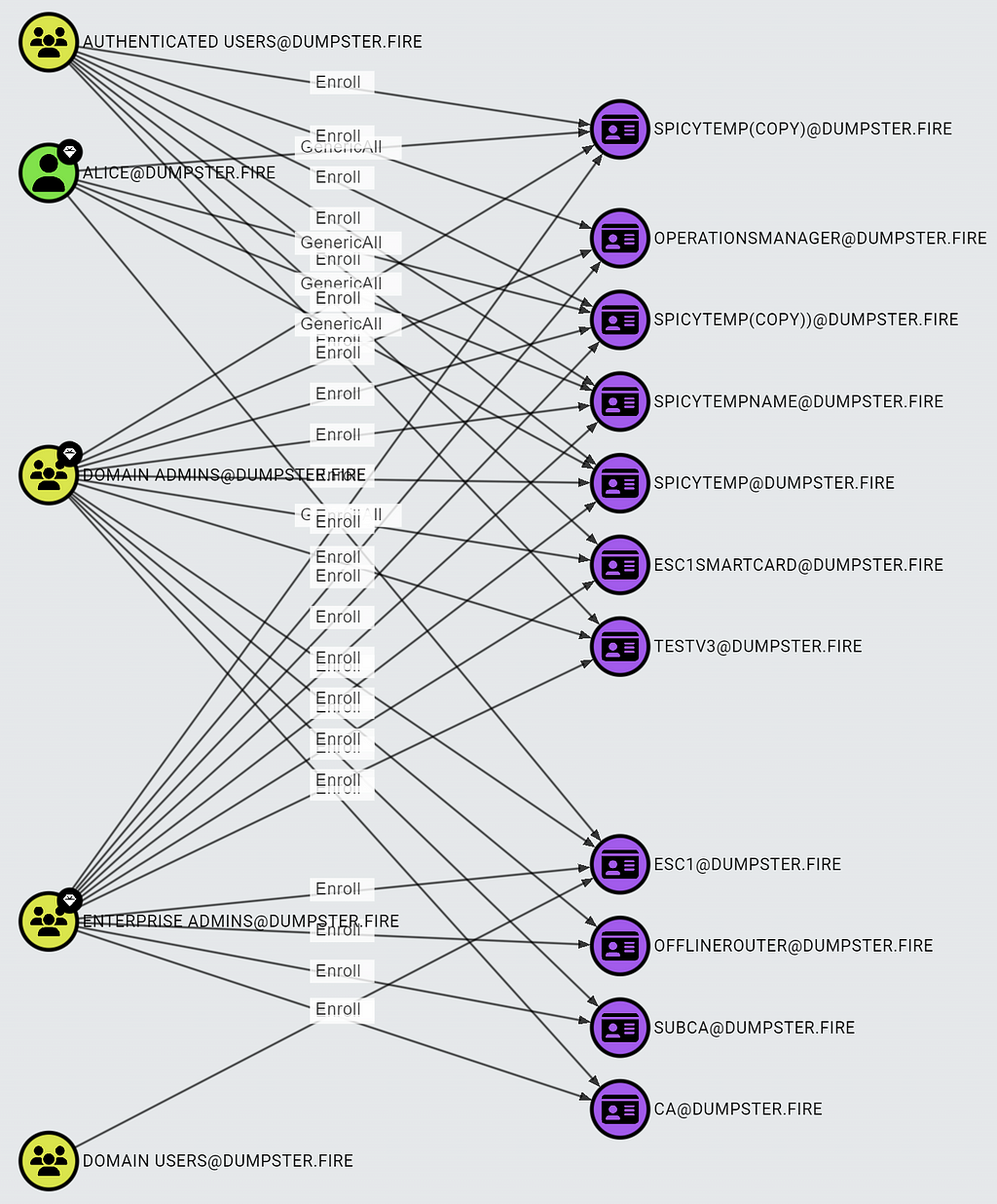
Enterprise CA Requirements
BloodHound now has an EnterpriseCA node type, representing the pKIEnrollmentService AD objects:

ESC1 Requirement 6: The Enterprise CA grants low-privileged users enrollment rights.
A principal must have the Enroll permission on the Enterprise CA to enroll for any published certificate template of the Enterprise CA. The Enterprise CA stores the permissions in registry on the computer hosting the Enterprise CA service, but you can also find the permissions in the DACL of the Enterprise CA AD object. However, the DC will not send changes made in the AD DACL to the Enterprise CA host, and the effective enrollment rights remain unchanged. SharpHound will attempt to collect both the AD DACL and the registry version and let the registry version overrule if SharpHound collects both successfully.
The non-traversable Enroll edge, already introduced under the CertTemplate node, implements the Enroll permission. We can find all principals with enrollment rights on Enterprise CAs with the Cypher query:
MATCH p = ()-[:Enroll]->(eca:EnterpriseCA)
RETURN p

ESC1 Requirement 7: The Enterprise CA is trusted for NT authentication.
When authenticating in AD using a certificate, the DC will check if it trusts the issuer of the certificate, the Enterprise CA, for NT authentication. It does that by checking if the issuer certificate is present in its local enterprise NTAuth store, cached in registry under HKLMSOFTWAREMicrosoftEnterpriseCertificatesNTAuthCertificates.
ADCS has a central NTAuth store. It is the object named NTAuthCertificates in the ADCS PKI container. It holds the certificates trusted for NT authentication in its caCertificate attribute. DCs of the AD forest replicate the values of this attribute to their local enterprise NTAuth stores using group policy.
To represent the NTAuth store in ADCS, we introduce the new NTAuthStore node:
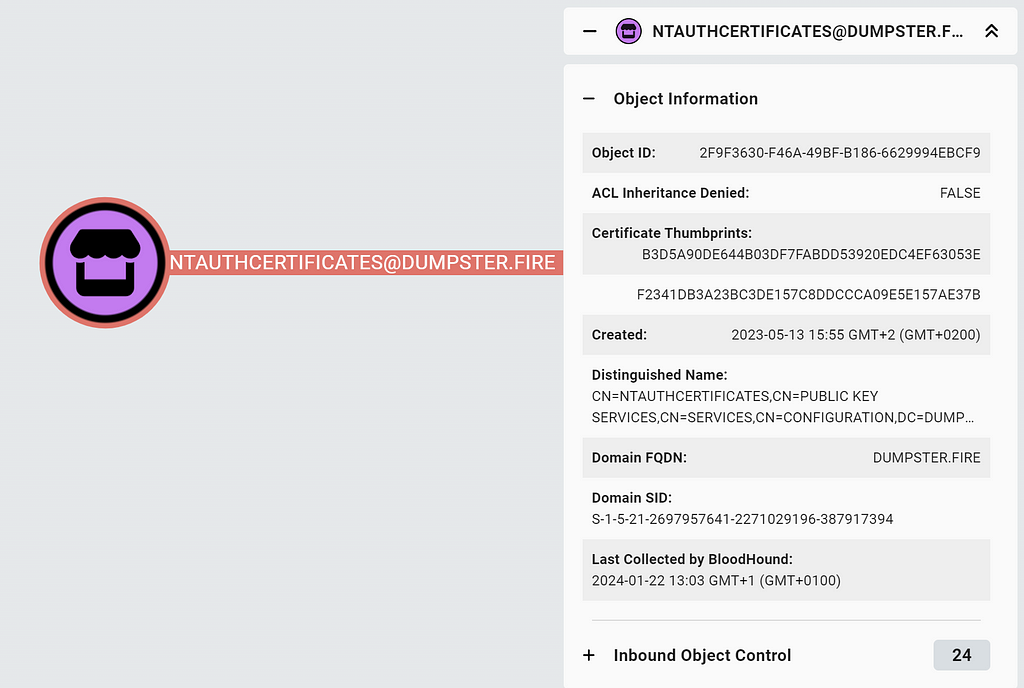
The “Certificate Thumbprints” entry in the entity panel holds the value of the node property certthumbprints, which represents the thumbprints of the certificates in the caCertificate attribute of the NTAuth store. Likewise, the EnterpriseCA node has a property, certthumbprint, which is the thumbprint of the certificate stored in the caCertificate attribute of the Enterprise CA AD object.
To make it easy to check the Enterprise CAs trusted for NT authentication, we have added a non-traversable edge called TrustedForNTAuth, going from EnterpriseCA nodes to NTAuthStore nodes. BloodHound creates the edge if the EnterpriseCA’s certthumbprint property value is present in the NTAuthStore’s certthumbprints property. As you might have multiple forests in your BloodHound graph, we have introduced another non-traversable edge, NTAuthStoreFor, going from the NTAuthStore node to the forest root domain the NTAuth store belongs to.
You can check the Enterprise CAs trusted for NT authentication with the following Cypher query:
MATCH p = (:EnterpriseCA)-[:TrustedForNTAuth]->(:NTAuthStore)
-[:NTAuthStoreFor]->(:Domain)
RETURN p
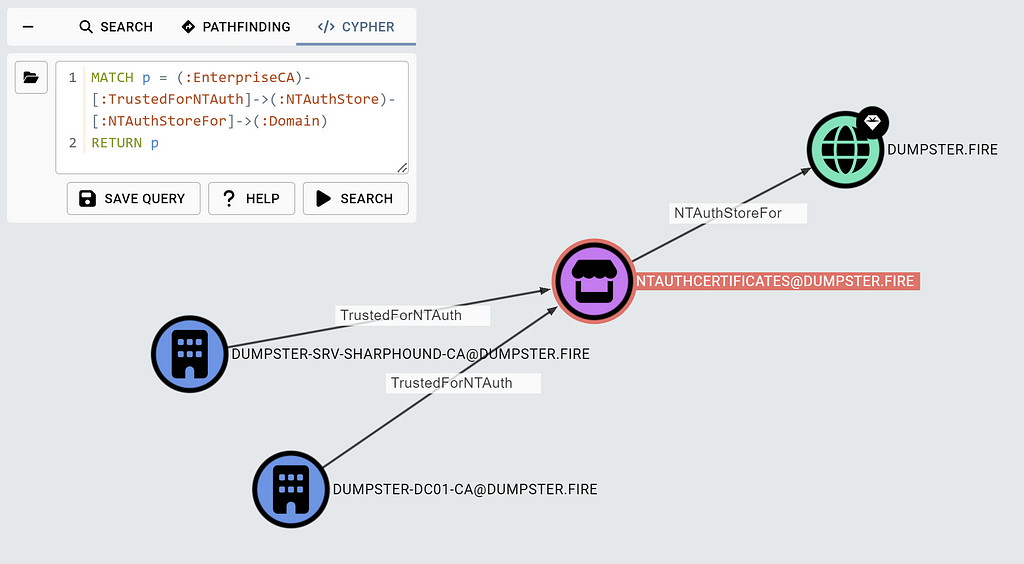
ESC1 Requirement 8: The Enterprise CA’s certificate chain is trusted.
It is not enough for the DC, that it trusts the issuer Enterprise CA for NT authentication. It will also check that it trusts all the certificates in the certificate chain. The certificate chain includes the certificate of the issuer CA, followed by the certificate of the CA which issued and signed the issuer CA’s certificate, and so on until it ends at a self-signed Root CA certificate.
The DC checks the certificates of the chain against its local intermediate CA store. Group policy automatically populates the store with the certificates of the AD NTAuth store, the certificates of the CA objects under the AIA container, and the certificates of the Enterprise CAs (located under the Enrollment Services container). Additionally, the DC verifies that it has the Root CA certificate in its local trusted Root CA store, which has the certificates of the Root CA AD objects of ADCS located in the Certification Authorities container.
To support certificate chain verification in BloodHound, we have introduced the AIACA and the RootCA node types:

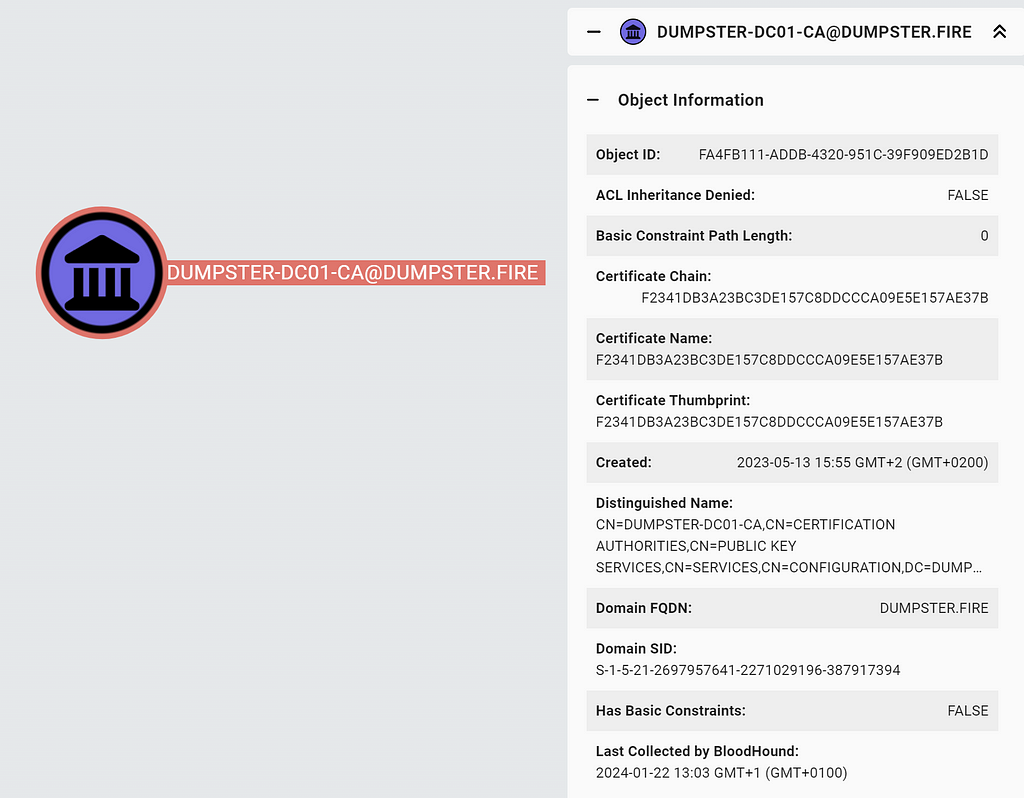
The AIACA, RootCA, and EnterpriseCA nodes all have a certthumbprint property containing the certificate thumbprint and a certchain property that holds a list of thumbprints of certificates in the certificate chain. To make it easy to check the certificate chain and show the PKI hierarchy, we have introduced the new non-traversable edge IssuedSignedBy, which goes from EnterpriseCA nodes to the next EnterpriseCA/RootCA in the certificate chain.
When you create an Enterprise or Root CA in ADCS, you will automatically also get and CA object in the AIA container representing the same CA. So AIACA nodes most commonly represent a CA which is also represented by an EnterpriseCA node or a RootCA node, to our understanding. For that reason, we do not create IssuedSignedBy edges to/from AIACA nodes, at least for now.
It is possible to install the CA enrollment service on a Root CA, such that the Root CA is also an Enterprise CA. This configuration exists if the organization has a single-tier CA hierarchy for example. In that case, we link the EnterpriseCA node to the corresponding RootCA node with an EnterpriseCAFor edge.
Additionally, we create a non-traversable edge, RootCAFor, going from the RootCA node to the forest root domain of the Root CA.
To check that DCs of the forest trust an Enterprise CA’s certificate chain, you can run the Cypher query:
MATCH p = (:EnterpriseCA)-[:IssuedSignedBy|EnterpriseCAFor*1..]->(:RootCA)
-[:RootCAFor]->(:Domain)
RETURN p
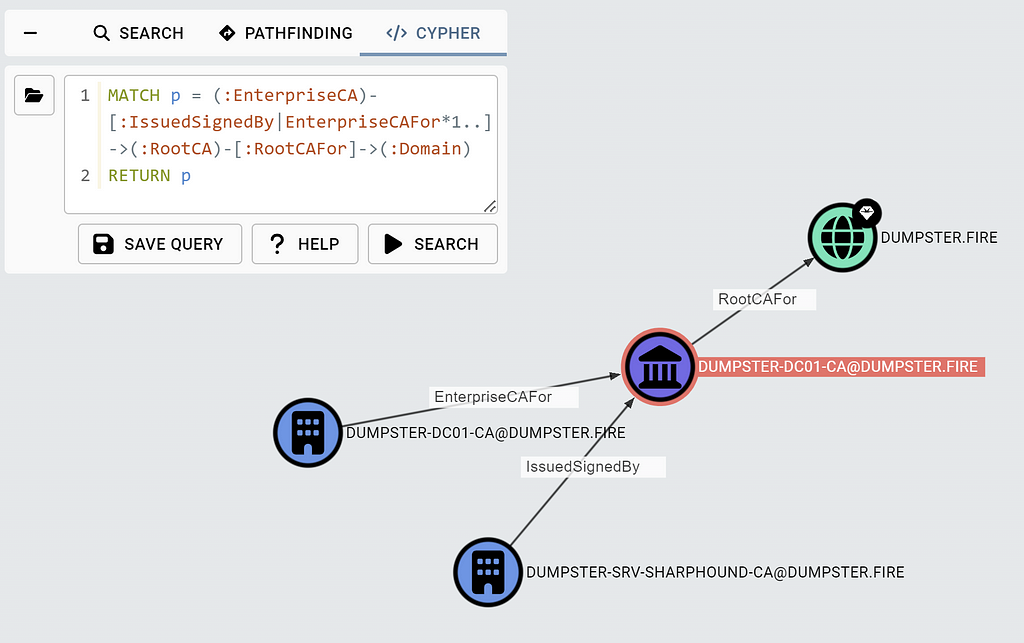
ESC1 Requirement 9: The Enterprise CA has the certificate template published.
The Enterprise CA AD object has an attribute named certificateTemplates, which is the name of the certificate templates the Enterprise CA has published. We use that in BloodHound to generate non-traversable PublishedTo edges from CertTemplate nodes to EnterpriseCA nodes.
You can check what CertTemplates are published to which EnterpriseCAs using the following Cypher query:
MATCH p = (:CertTemplate)-[:PublishedTo]->(:EnterpriseCA)
RETURN p
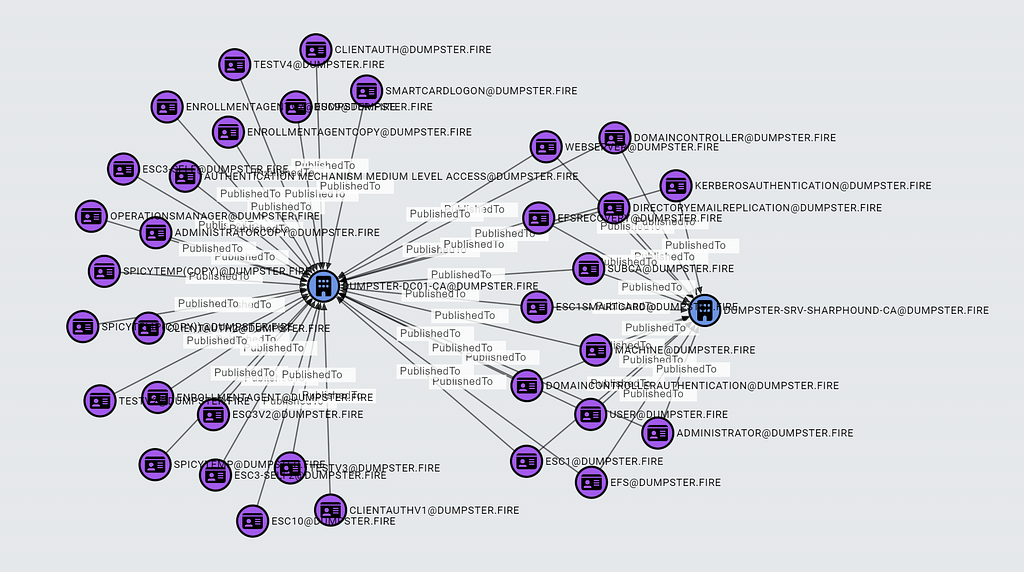
Putting It All Together
We now know how to check for all the ESC1 requirements using Cypher. We could potentially use some cypher-fu to combine all the queries and find the intersection of principals that have enrollment rights on both the ESC1 CertTemplates and the EnterpriseCAs where published. But there’s no need for that — BloodHound does it for you. To see what principals can perform ESC1, you can simply check for the new ADCSESC1 edge:
MATCH p = ()-[:ADCSESC1]->()
RETURN p
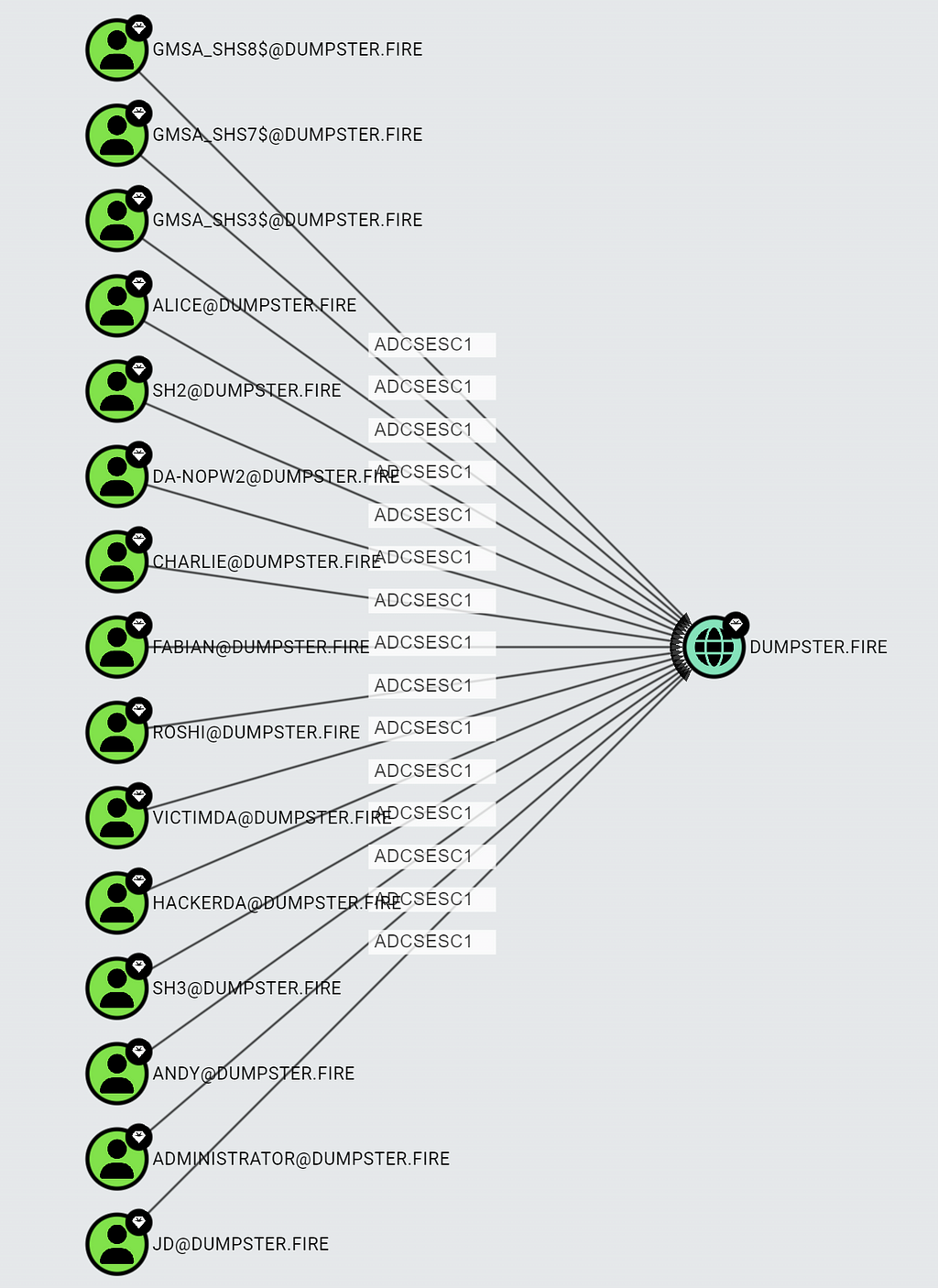
The edge ends at the forest root domain, as ESC1 enables the principal to authenticate as any principal in the forest. The edge is traversable, so ADCSESC1 will appear in pathfinding search if it is part of the shortest path to the target:
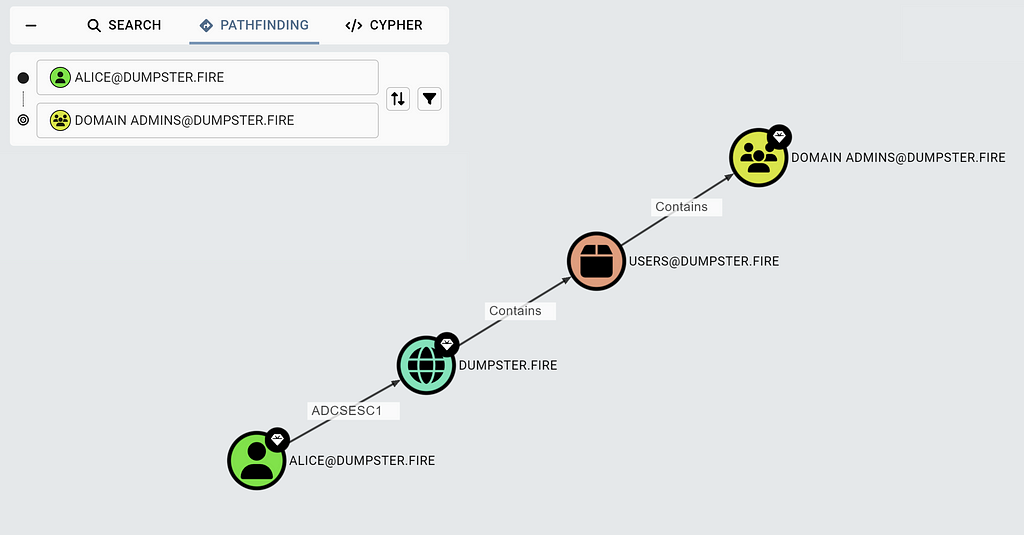
To know that ESC1 is possible is great, but you also need to know the details of how and why it is possible, both as a red teamer and a blue teamer. To get that info, click on the edge, and click on Composition:
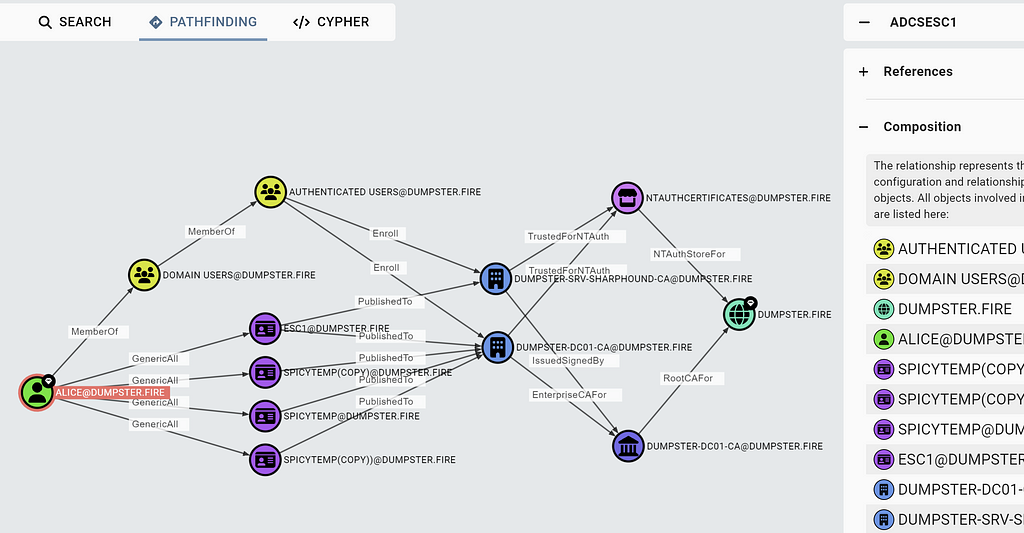
The composition will show you all the nodes and edges involved in meeting the requirements for the principal to have the ADCSESC1 edge. It might show you multiple options, like in the screenshot above, where Alice has four certificate templates and two Enterprise CAs to choose from if she wants to perform an ESC1 attack. The abuse sections in the entity panel provide info about how the attacker can execute the attack, as usual.
New Data Collection
The ADCS AD objects exist in the Configuration NC (Naming Context). This partition is forest-wide and replicated to all writeable DCs in the AD forest. SharpHound has traditionally only collected data from the Default NC, but we have extended SharpHound to collect the ADCS containers and objects in the Configuration NC when using the collection method CertServices, included in Default, DCOnly, and All. There are no special requirements for the Configuration NC collection, you simply need to collect from a single DC in the forest. SharpHound will collect the ADCS objects over LDAP, just like the regular AD objects from the Default NC.
SharpHound v2.3 (or later) supports the ADCS collection. We highly recommend using the latest version, which you can download in BloodHound CE or from the SharpHound GitHub repo. Make sure you are also using the latest BloodHound CE version. You can upgrade on Linux using this cmdlet: docker compose pull && docker compose up -d or on Windows using this PowerShell cmdlet: docker compose pull; docker compose up -d. If you have not installed BloodHound CE yet, follow the instructions here: Install BloodHound Community Edition with Docker Compose.
You can enable the ADCS early access feature in BloodHound in Administration under Early Access Features:
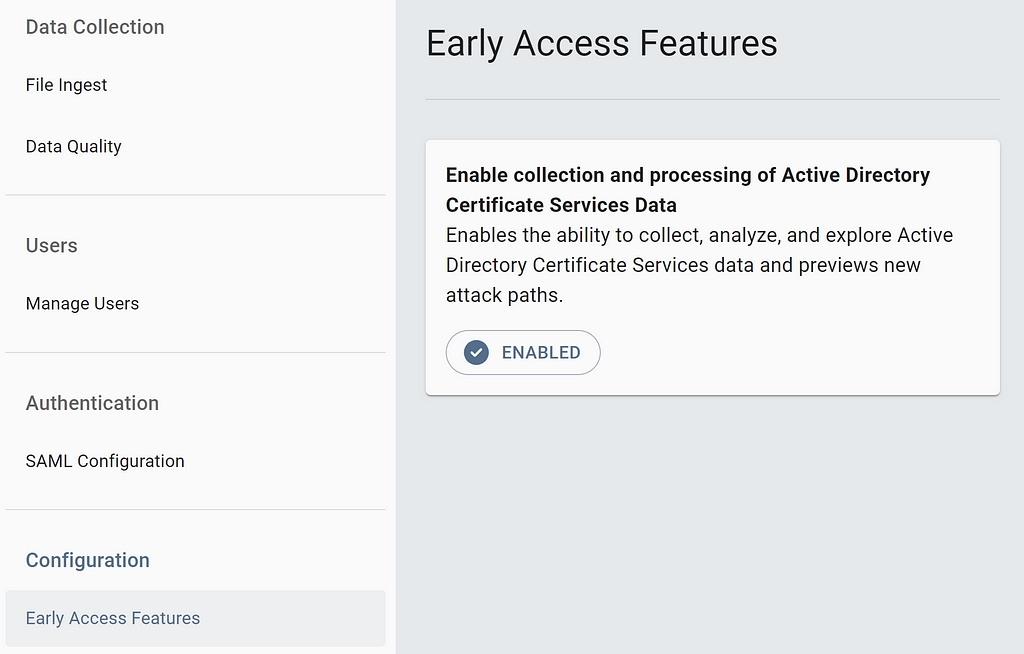
ADCS in BloodHound Enterprise
BloodHound Enterprise customers will automatically see findings in the Attack Paths tab if principals not marked as Tier Zero have the ADCSESC1 edge:
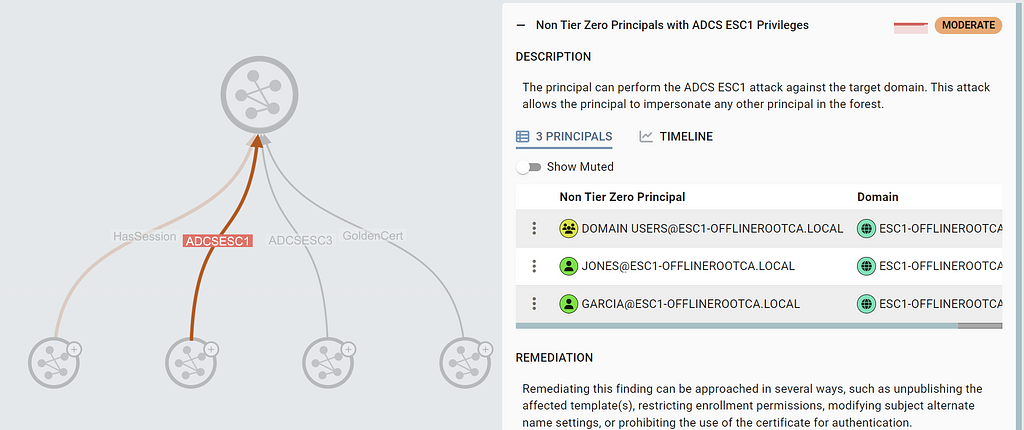
The exposure percentage of the finding determines the finding severity, as for other graph-based findings.
Since ESC1 has multiple requirements that need to be met, there are also multiple ways to remediate the finding. Our recommended remediation will therefore suggest multiple options, all described in detail, and guide towards the best remediation based on the current usage of certificate templates involved:

What is Next?
As you can tell from the title of this blog post, this is the first of a series on ADCS attack paths in BloodHound. So stay tuned, as we will dive into some of the more advanced ADCS escalations and how you can identify them using BloodHound.
We are very eager to get your feedback. Please join us in the BloodHound Slack or report any issues on the BloodHound GitHub repo.
ADCS Attack Paths in BloodHound — Part 1 was originally published in Posts By SpecterOps Team Members on Medium, where people are continuing the conversation by highlighting and responding to this story.